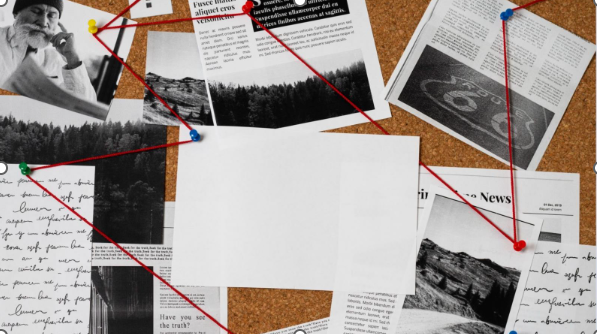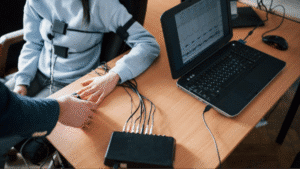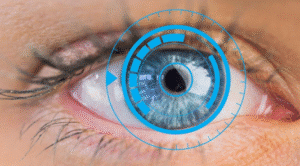The modern polygraph machine is a sophisticated device that utilizes advanced computer algorithms to record and analyze physiological data.
While brands differ, most lie detector tools come equipped with various sensors. The sensors are built into special tubes, which an examiner connects to an examinee’s body to measure certain physiological responses linked to deception.
Commonly monitored parameters include heart rate, blood pressure, skin conductivity, and breathing rate. Studies have shown that lying changes all four physiological functions. Therefore, significant deviations from premeasured baselines potentially indicate deception.
Digital polygraph machines are a step-up from their analog counterparts, which mechanically record data on continuous paper charts known as polygrams.
But the concept of lie detection didn’t begin with the polygraph machine (digital or analog). For millennia, humans have consistently employed several techniques to sniff out deceptive individuals.
Pre-Polygraph Lie Detection Techniques

The modern polygraph test has been around for over a century. However, humans have employed various primitive lie detection tools for millennia. Striking examples include;
1. Physiological Monitoring in the Greeks
Ancient Greece is renowned for its gallant warriors and inspirational philosophers. This civilization also popularized several lie detection techniques, which were largely based on speech analysis.
Besides tracking speech patterns, ancient Greeks also sniffed out liars by visually observing physiological responses like heart rate and breathing patterns. Note that these are the same parameters measured by the modern polygraph machine.
2. Trial by Ordeal in Medieval Europe
Numerous cultures employed trial by ordeal to catch liars. However, the practice was widely popular across Medieval Europe.
Trial by ordeal involved subjecting the accused to dangerous tests. The belief was that God, or the Gods, would save the truthful individuals and punish the deceptive ones.
Common trial by ordeal methods included:
a) Trial by Fire
Trial by fire involved having suspects walk through blazing fire or handle hot iron. If they were innocent, divine intervention would save them from burning.
It’s unclear where this practice originated. However, it’s eerily similar to the Biblical account of the three Hebrew boys thrown into the fiery furnace in the Book of Daniel.
b) Trial by Water
In a trial by water, accused persons were thrown into the water. The innocent were expected to float as the guilty sank.

3. Rice Chewing
Rice chewing was a primitive lie detection tool with roots in China, premised on the belief that lying diminished salivation.
Suspects had to chew dry rice during interrogations. Truthful individuals could spit out the rice with remarkable ease, while the guilty ones struggled to do so.
4. Stabled Ass Test in India
In ancient India, a sacred ass was stabled and its tail bathed in black powder. The ass was then kept in a dark room, and suspects were asked to go in and pull its tail.
Wary of divine wrath, guilty suspects avoided touching the ass’s tail. Innocent ones proceeded to pull the tail, causing the animal to bray.
Suspects would then leave the dark room and have their hands examined as evidence of contact with the ass’s tail.
5. Non-verbal Cues
This is perhaps the ancient lie detection technique that’s still relevant today. Many cultures relied on non-verbal cues, such as facial expressions and hand gestures, to discern deception. Nervous fidgeting, nose twitching, and breaking eye contact were all associated with deception.
6. Consulting Oracles
As a last resort, some cultures consulted oracles as a way to detect liars. Oracles did not just point out the liar from a pool of suspects. They often also pronounced divine judgments, which often included having the guilty ostracized or killed.

Enters the Polygraph
Pre-Larson Period
One of the earliest versions of the polygraph machine was an instrument known as plethysmograph. Invented in 1878 by Italian physiologist Angelo Mosso, this tool was used to detect blood pressure changes triggered by certain stimuli.
In 1892, Sir James Mackenzie developed an instrument for use in measuring blood pressure and heart rate. Mackenzie’s invention garnered widespread use in the medical industry.
Three years later, Italian criminologist Cesare Lombroso modified an existing device called a hydrosphygmograph to create an instrument that measured pulse and blood pressure changes.
In 1915, Dr. William Moulton Marston also contributed to the development of the polygraph machine. Marston’s device largely tracked changes to systolic blood pressure.
The Post-Larson Period
John A. Larson is credited for playing the biggest role in developing the first iteration of the modern polygraph machine. In 1921, Larson’s created a device that measured changes in heart rate, blood pressure, and respiration with incredible accuracy.
In 1939, another inventor – Leonarde Keeler – improved existing polygraph machines by adding galvanic skin response (GSR) sensors.
Polygraphs gained widespread acceptance throughout the ‘60s, with about 20,000 lie detector tests conducted in 1963 alone. In the early 1990s, lie detector machines eventually went digital.

Revolutionizing Lie Detection Through Cutting-Edge Polygraph Machines
The polygraph isn’t the first lie detection tool in human history. Numerous other techniques predate it.
However, the modern polygraph machine is arguably the most effective lie detection tool ever invented. While the technique still falls short of the Daubert standard (except for single-issue exams), working with a professional examiner can help meet certain forensic standards for evidence reliability.
Besides, you can improve the outcome of polygraph tests by investing in a high-end machine.
Consider digital lie detectors equipped with advanced sensors for accurate data collection. The machine should also come with high-speed hard disks for fast information processing and intuitive software for a seamless user experience.






